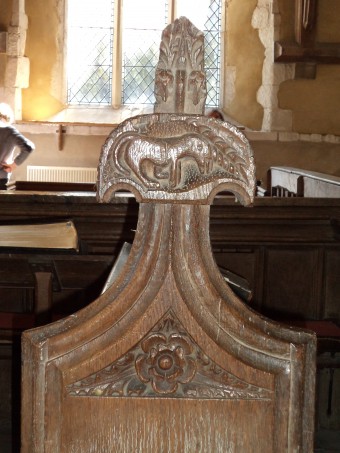Even though the coming election continues to dominate national and local news, I thought I would look elsewhere for my short topic this week. Yesterday I took two groups of American undergraduates on walking tours of medieval Canterbury. These students are studying for a semester at Fordham University’s London campus and have been looking in detail at medieval London. Thus Canterbury provided an interesting contrast, as well as the link, for example, between the start and finish of the pilgrimage taken by Chaucer’s band of pilgrims. I am going to keep the Chaucer link going, not least because of his opening lines regarding April weather. However this year he would be said to have got it wrong, albeit last Wednesday was certainly truly exceptional.
Unicorn bench end, Westwell church near Ashford, held by Canterbury
Although not directly related to the arrival of the students, I was in the newly reopened Canterbury Cathedral archives after the Easter break last Wednesday and was working my way through the city’s chamberlains’ accounts for the decades either side of 1500. Going back over old ground can sometimes be rewarding, especially when looking at the materials in respect of a different topic. So, yes, I should have spotted these entries before because they weren’t what I was searching for this time either. Nevertheless they are useful additions, and I thought I would pass on details about ‘The Hale in the Blean’, but I’ll leave the moveable fish market perhaps for another time.
For those not familiar with the ‘Hale’, this was a tented encampment that was provided by the city’s civic authorities for royal pilgrims coming to the martyr’s shrine in the cathedral.
Although Canterbury’s civic officers would not have provided anything on the scale of ‘The Field of the Cloth of Gold’, this is a long way away from a modern camping holiday. It is not totally clear from the city records exactly when this hospitality was initiated, but there are references to expenses linked to the Blean in terms of the queen’s visit in 1401-2.
More references follow in the early years of Henry VI’s reign, and for 1447-8 there is a specific note concerning ‘unum Hale’ for Henry’s pilgrimage that year to Canterbury.
Thereafter references become more abundant as the Hale was refurbished before royal guests arrived and provisions were carted up to it, including bread, red and white wine and other tasty victuals.
Nevertheless, what was not recorded was exactly where this Hale was sited because, of course, those who needed to know knew perfectly well – a familiar problem for the historian. Which brings me to what I finally noticed on Wednesday, even though I had heard it said that the Hale was there, albeit others who have studied the topography are less convinced, but I’ll return to that in a minute.
So yes, I had noticed in the past that Queen Elizabeth had been given a purse of gold when she came on pilgrimage to Canterbury for the first time after her coronation, but I had missed (or not bothered to note) that wood for the tents of the king and queen was carried to Harbledown.
The work on the Hale that year costing the chamberlains in total 25s 4d. Furthermore, four years later work on the fabric of the king’s tents is again noted as having taken place at Harbledown.
Now if anyone knows where this is likely to have been I would be very interested to hear, and perhaps it is just that I have missed research that has been done by others already.
Turning to the site which has been put forward as a possible location for the Hale to the east of Harbledown, I am now wondering whether this might just possibly be the shadowy hospital of St John in the Blean?
Again this is one of those tantalising institutions about which almost nothing is known beyond a few stray documentary references. In this case the place was taken over by St Thomas’ hospital or Eastbridge before 1239 but what exactly they acquired is very unclear. It may have been a simple wooden structure, albeit one assumes with at least a chapel (altar to St John), that offered accommodation to poor pilgrims unable to reach Canterbury that night, but whether it was anything more substantial is unknown and probably never will be.
So you might say this week is more about questions than answers and again underlines just how important Canterbury was during the Middle Ages, a point that I raised with the Americans yesterday and will also be in evidence at the Centre’s Medieval History Weekend next April – details will be available next month.
 Centre for Kent History and Heritage
Centre for Kent History and Heritage Sheila Sweetinburgh
Sheila Sweetinburgh 670
670


